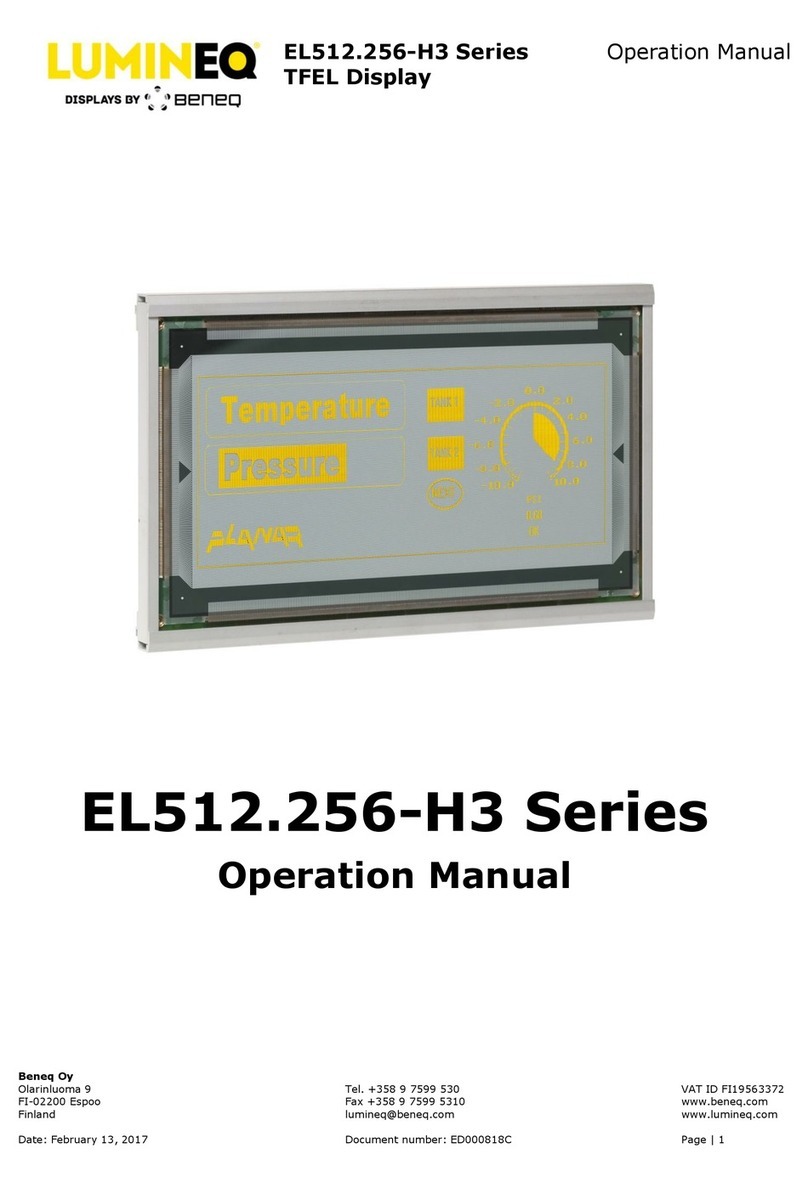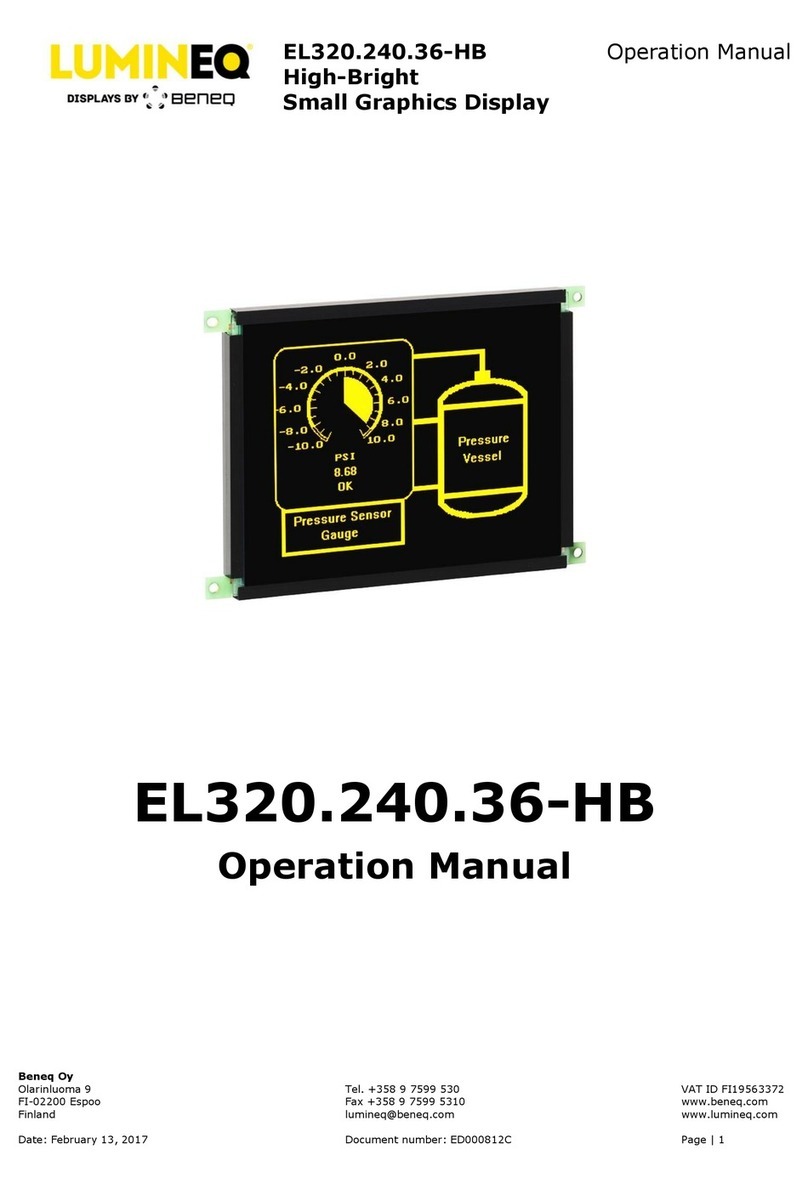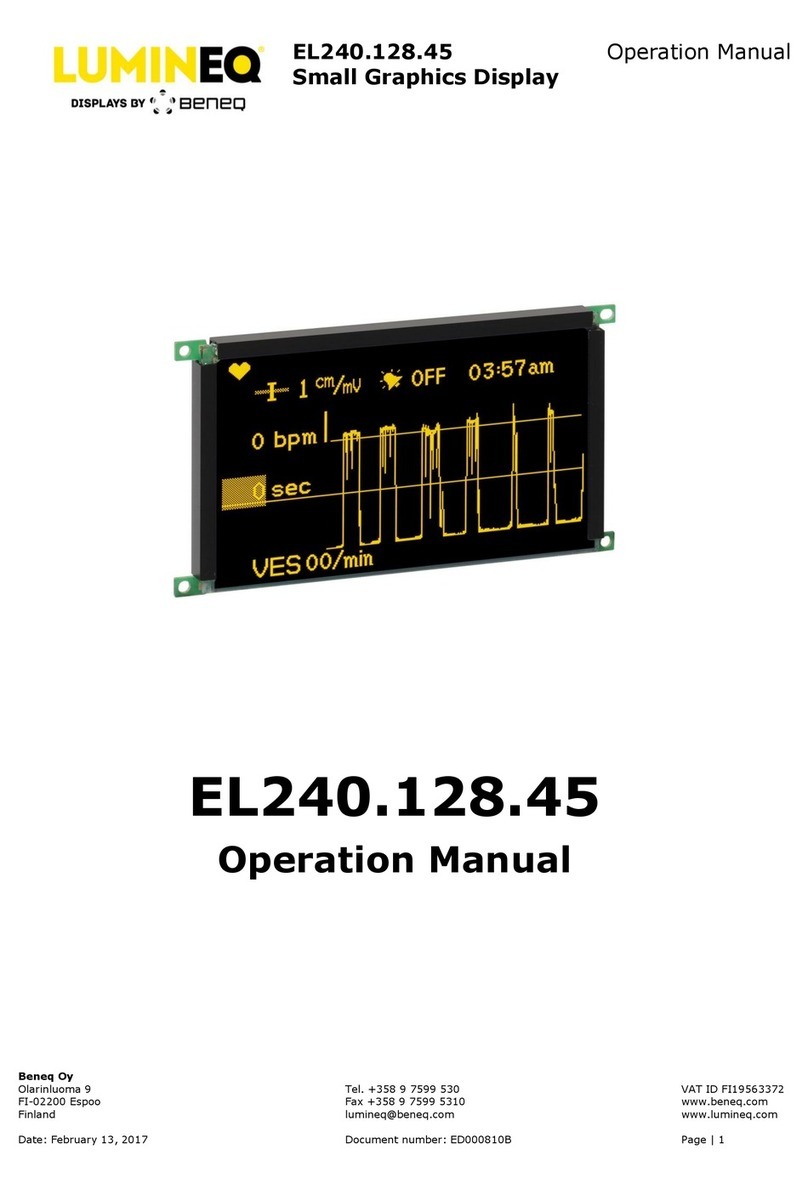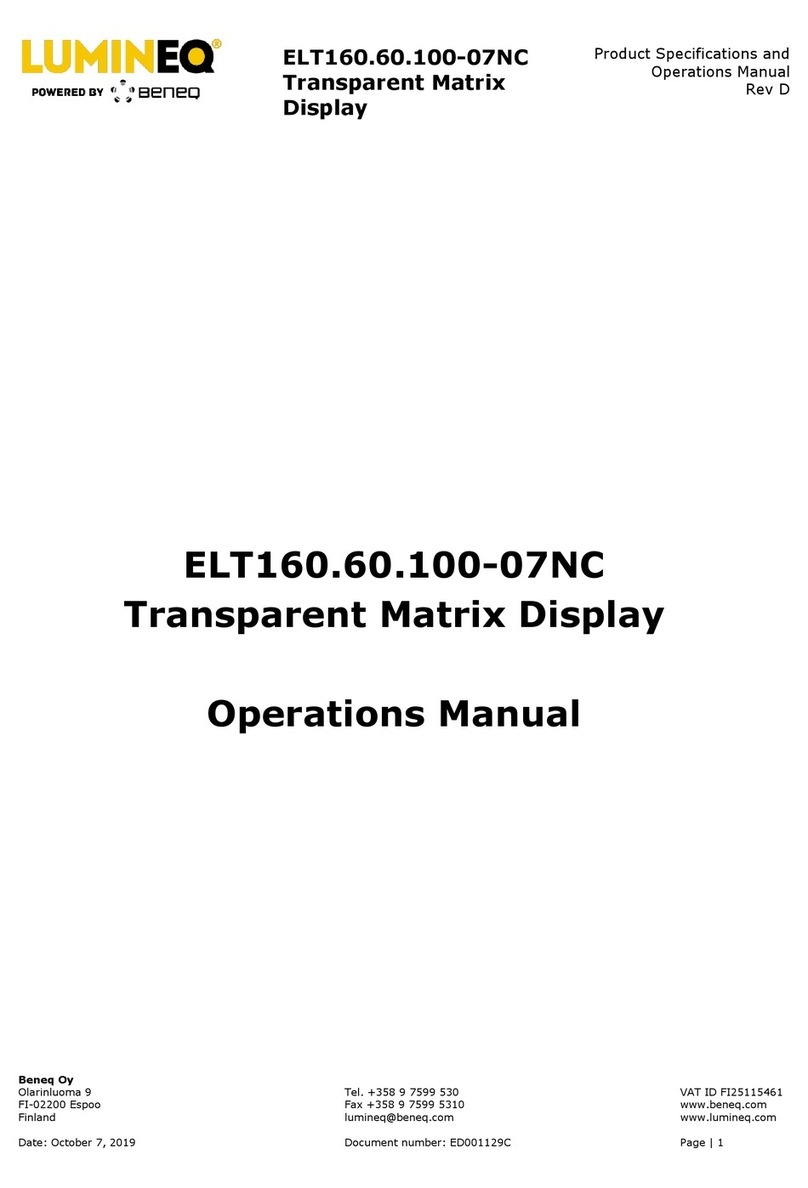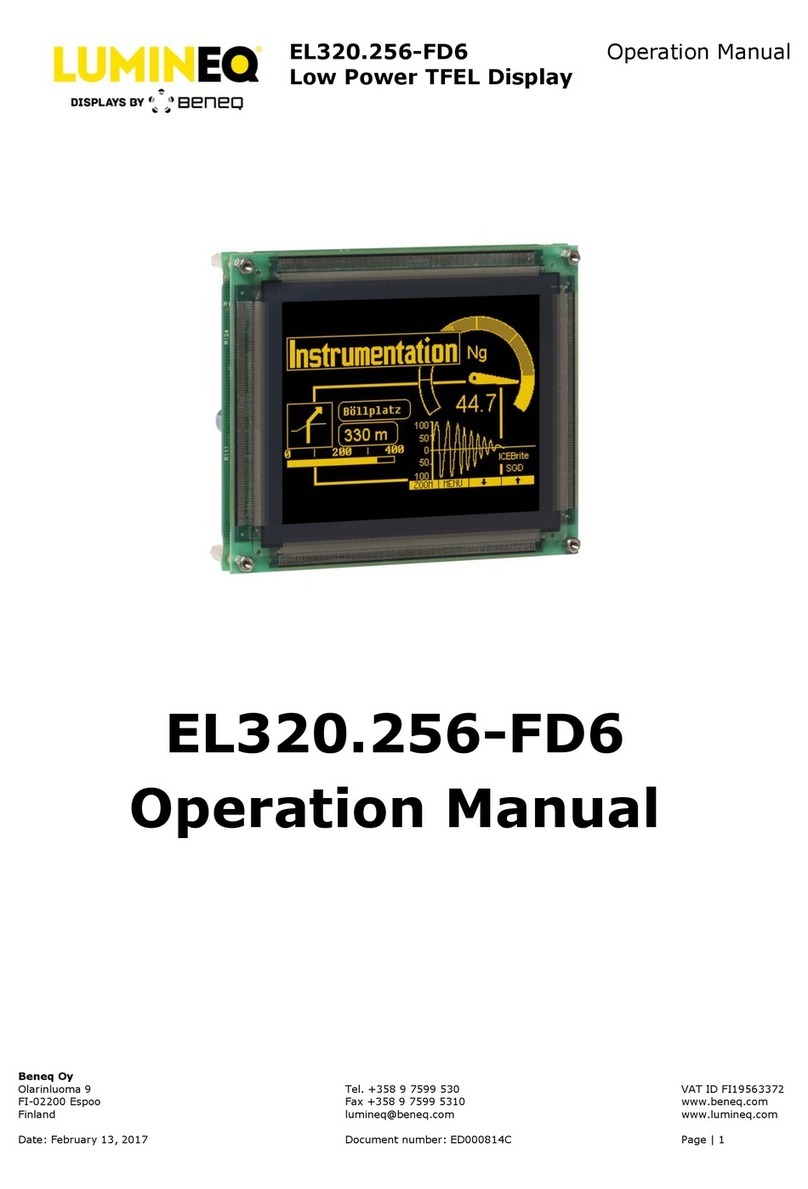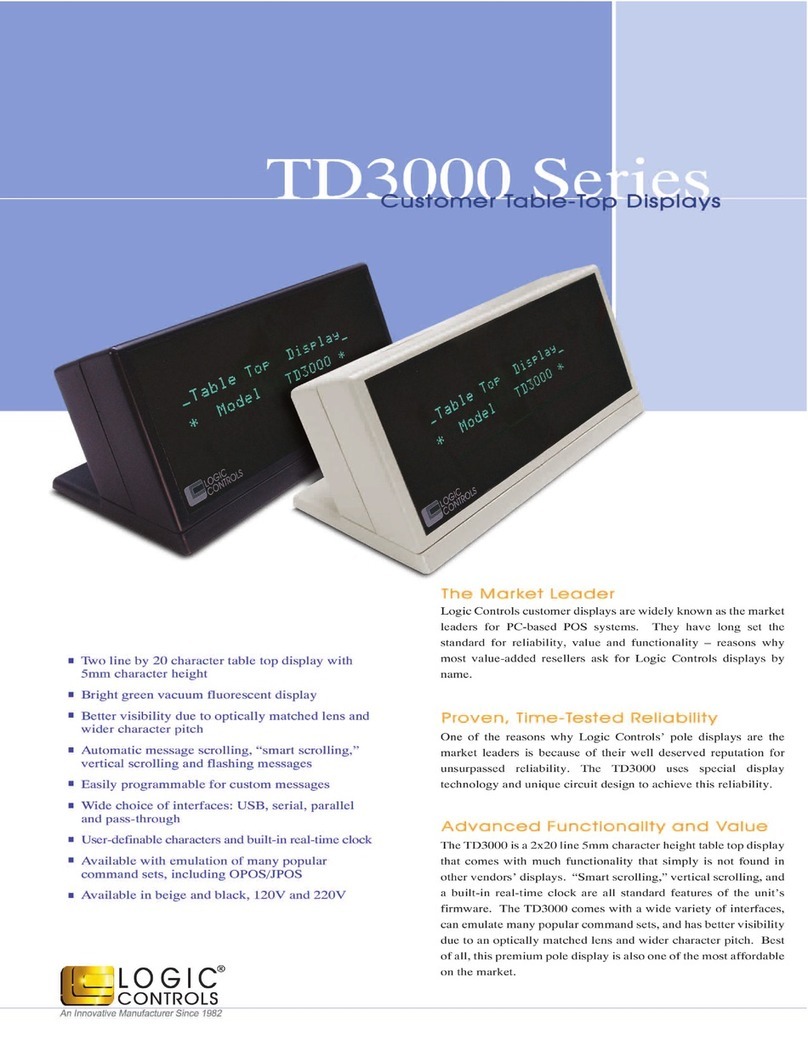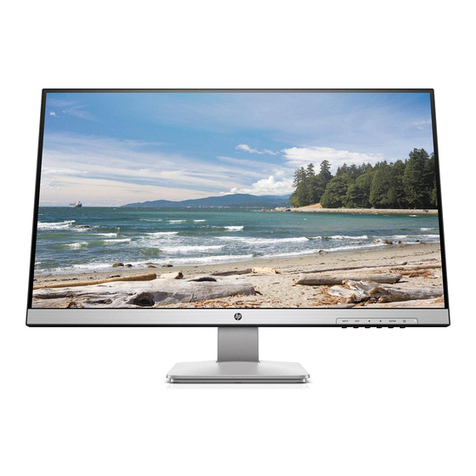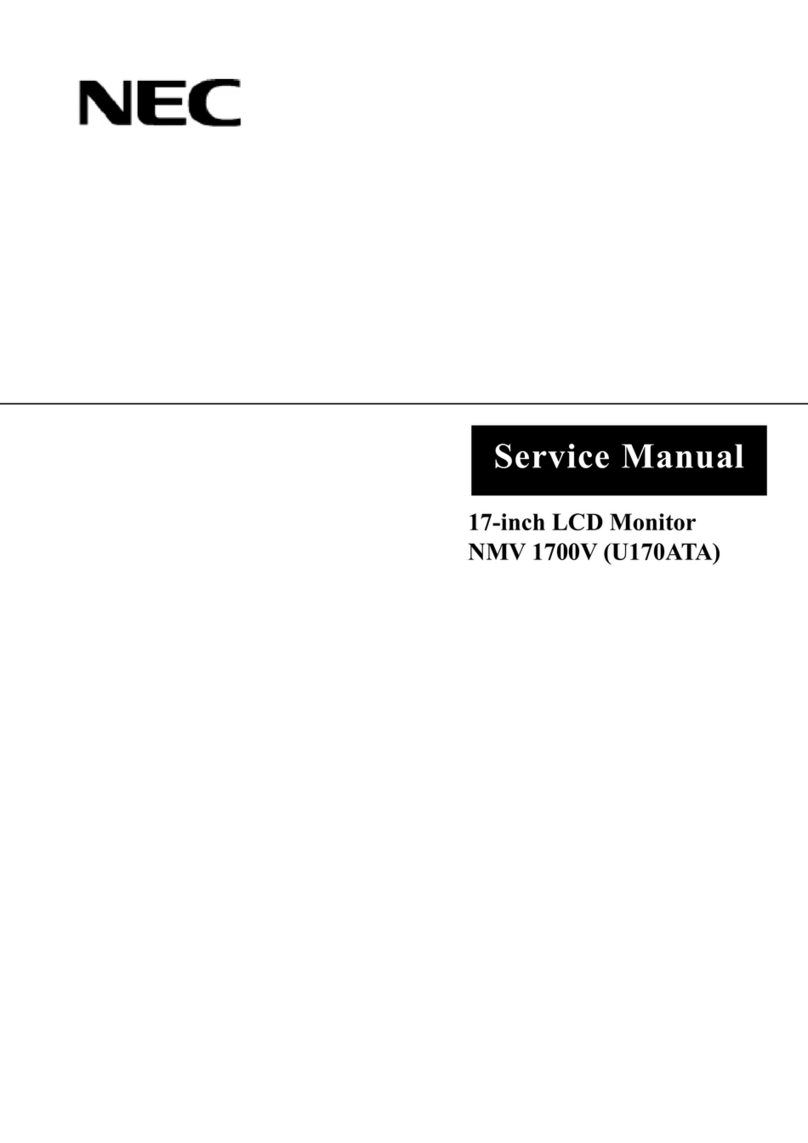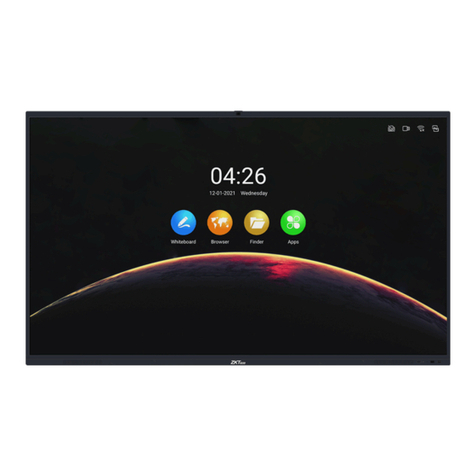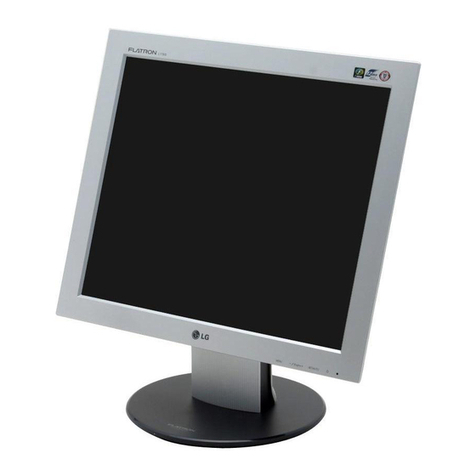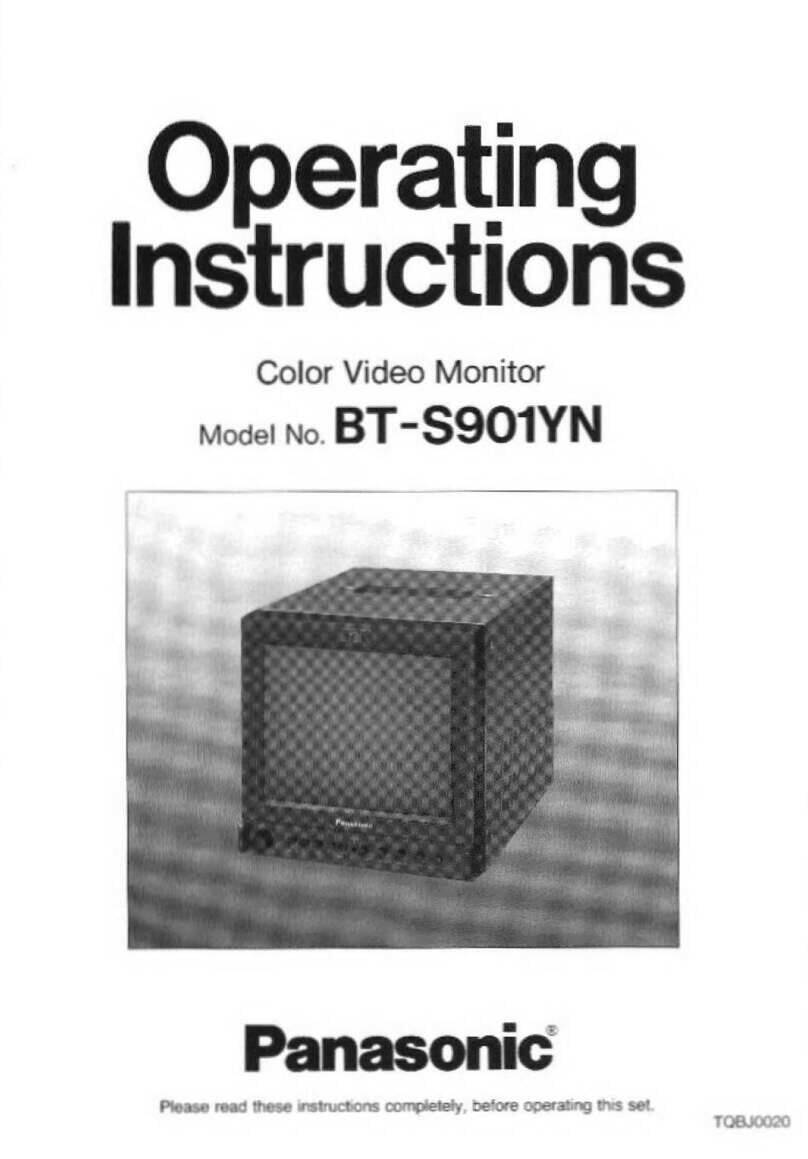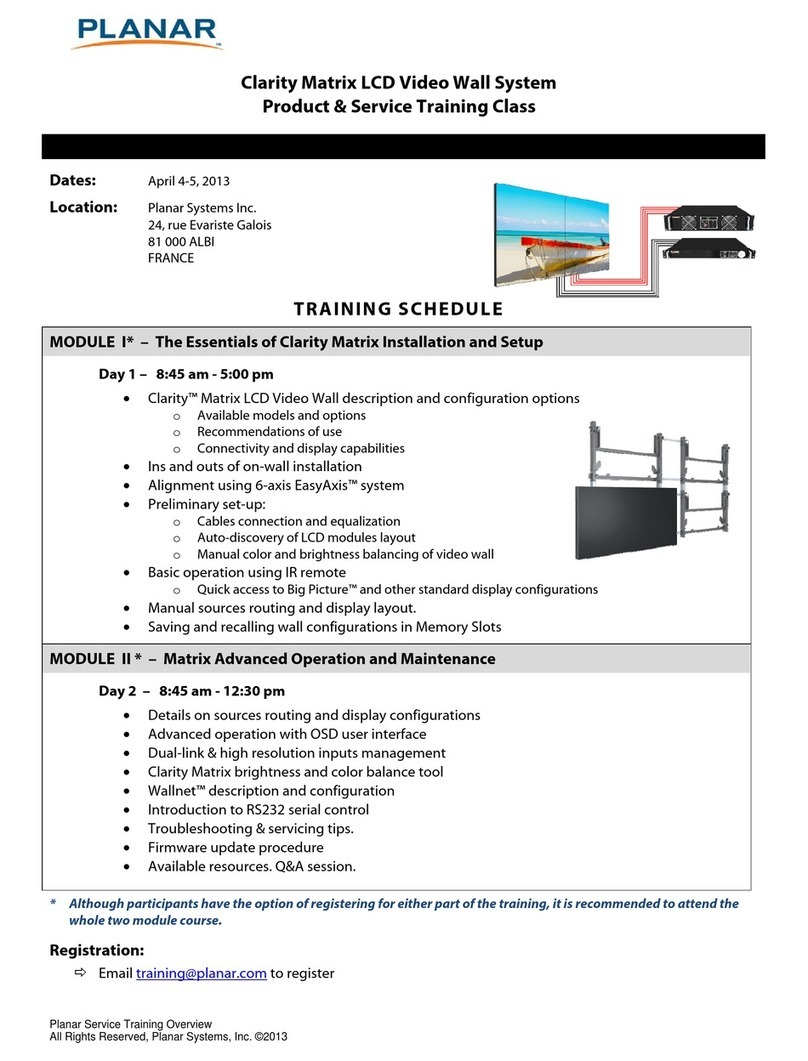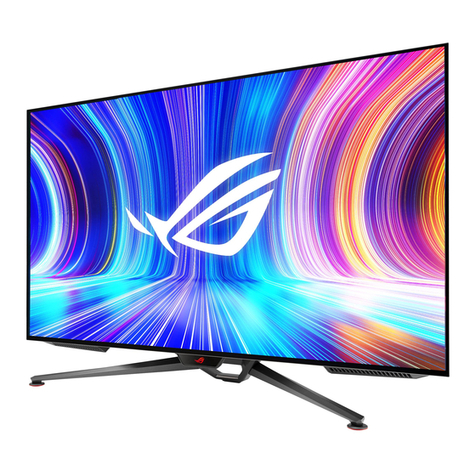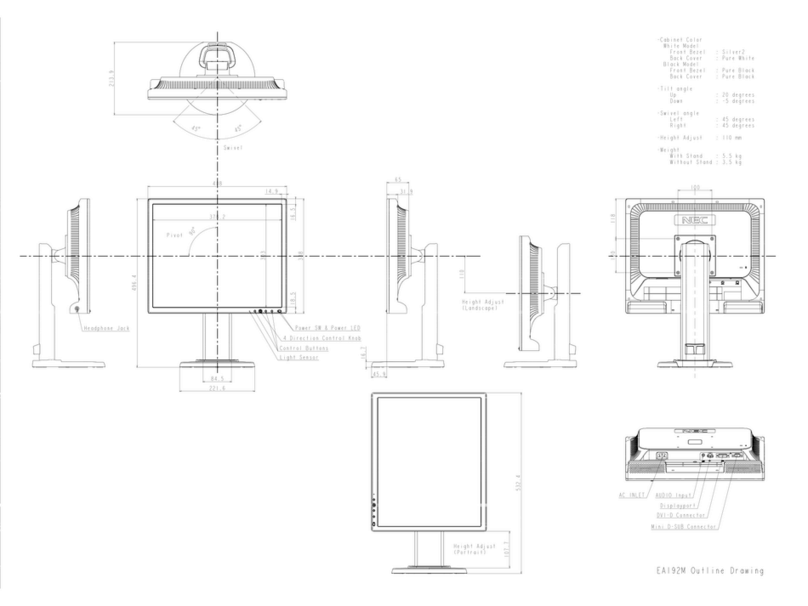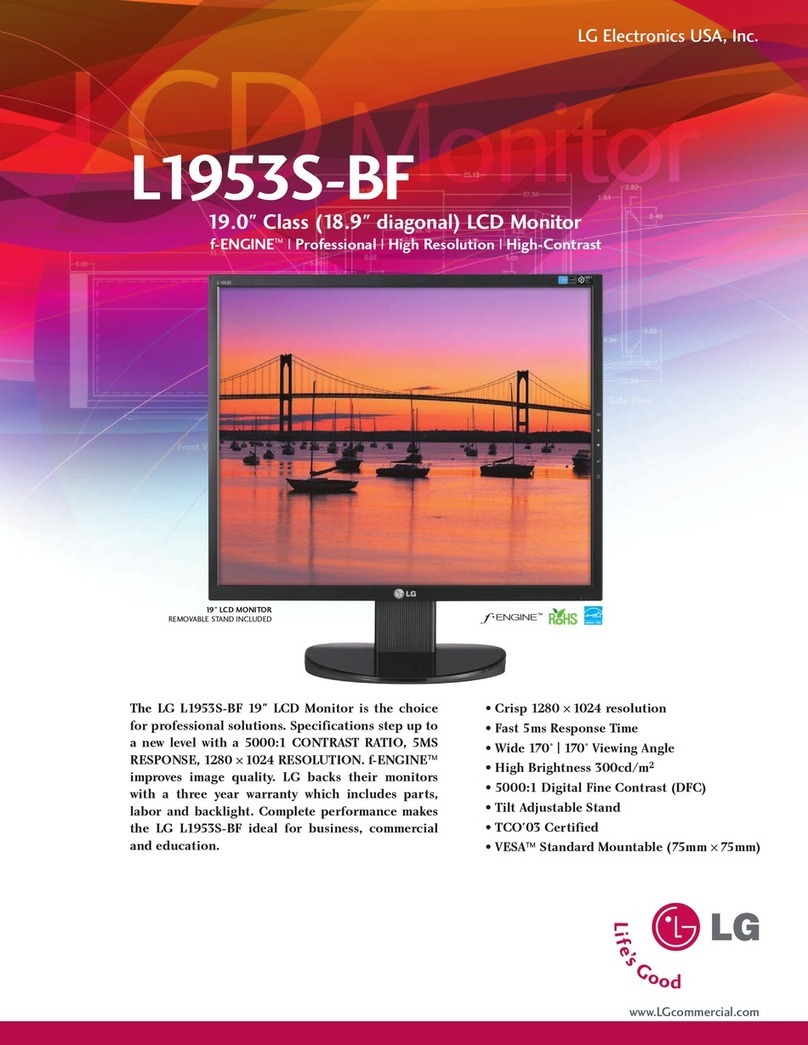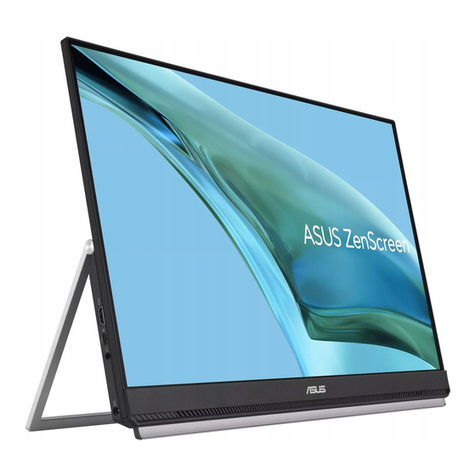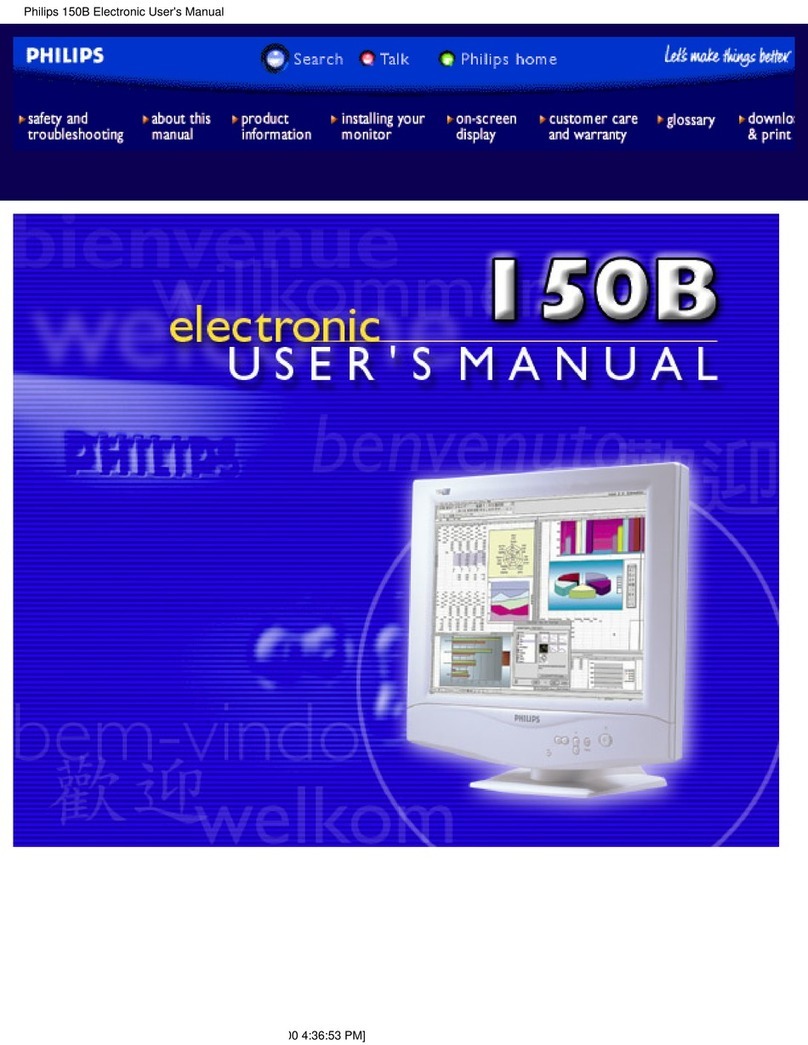beneq Lumineq EL320.240-FA3 User manual

EL320.240-FA3
Multi-Color
QVGA TFEL Display
Operation Manual
Beneq Oy
Olarinluoma 9
Tel. +358 9 7599 530
VAT ID FI19563372
FI-02200 Espoo
Fax +358 9 7599 5310
www.beneq.com
Finland
lumineq@beneq.com
www.lumineq.com
Date: February 13, 2017
Document number: ED000813B
Page | 1
EL320.240-FA3
Operation Manual

Operation Manual
EL320.240-FA3 Display
Beneq Oy
Olarinluoma 9
Tel. +358 9 7599 530
VAT ID FI19563372
FI-02200 Espoo
Fax +358 9 7599 5310
www.beneq.com
Finland
lumineq@beneq.com
www.lumineq.com
Date: February 13, 2017
Document number: ED000813B
Page | 2
Table of contents:
1EL320.240-FA3 multi-color QVGA display ................................................................................................ 3
1.1 Features and benefits .................................................................................................................... 3
2Installation and set-up.......................................................................................................................... 4
2.1 Mounting TFEL displays.................................................................................................................. 4
2.2 Cable length ................................................................................................................................. 4
2.3 Cleaning....................................................................................................................................... 4
2.4 Avoiding burn-in ........................................................................................................................... 4
2.5 Power supply and video sequencing and overcurrent protection .......................................................... 5
2.6 Internal frame buffer ..................................................................................................................... 5
2.7 Color bit-mapping and color considerations ...................................................................................... 5
2.8 Display overlay considerations ........................................................................................................ 6
3Specifications and operation .................................................................................................................. 7
3.1 Environmental .............................................................................................................................. 7
3.2 Over-temp condition...................................................................................................................... 7
3.3 Optical......................................................................................................................................... 8
3.3.1 Displayed colors .................................................................................................................... 8
3.4 Power ........................................................................................................................................ 10
3.5 Display interface ......................................................................................................................... 11
3.5.1 Video mode selection ........................................................................................................... 12
3.5.2 Connector........................................................................................................................... 13
3.5.3 Display input descriptions ..................................................................................................... 14
3.5.4 Video mode timing—SGD video mode..................................................................................... 15
3.5.5 Video mode timing—AMLCD video mode, QVGA....................................................................... 17
3.5.6 Video mode timing—AMLCD video mode, QVGA, fixed .............................................................. 18
3.5.7 Video mode timing—AMLCD video mode, VGA......................................................................... 19
3.5.8 Video mode timing—AMLCD video mode, VGA, fixed ................................................................ 20
3.6 Dimming .................................................................................................................................... 21
3.7 Self-test mode ............................................................................................................................ 22
3.8 Reliability ................................................................................................................................... 22
3.9 Safety and EMI performance......................................................................................................... 22
3.10 Mechanical characteristics ............................................................................................................ 23
3.10.1 Display dimensions and component envelope .......................................................................... 23
4Description of warranty....................................................................................................................... 25
5Ordering information .......................................................................................................................... 25
6Support and service............................................................................................................................ 26
7RoHS II............................................................................................................................................. 26

Operation Manual
EL320.240-FA3 Display
Beneq Oy
Olarinluoma 9
Tel. +358 9 7599 530
VAT ID FI19563372
FI-02200 Espoo
Fax +358 9 7599 5310
www.beneq.com
Finland
lumineq@beneq.com
www.lumineq.com
Date: February 13, 2017
Document number: ED000813B
Page | 3
1EL320.240-FA3 multi-color QVGA display
The EL320.240-FA3 thin film electroluminescent (TFEL) multi-color display is a high-
performance alternative to QVGA (320 x 240) LCDs and the ideal solution in demanding
applications where superior visual performance, extreme temperature range, and
environmental ruggedness are critical.
The EL320.240-FA3 utilizes Lumineq®Displays’ proprietary Integral Contrast Enhancement
(ICEBrite™) technology combined with red and green filters patterned over Lumineq Displays’
industry-leading yellow phosphor to achieve unparalleled image quality in hues of red, green
and yellow. Three intensity levels in each of the red and green sub-pixels generate 16 distinct
colors (9 chromatically different colors, black, and 2 mid-levels of red, green, and yellow.)
The display consists of a solid state TFEL glass panel, depicted below, with a 124 mm
diagonal active area, and control electronics assembled into a space-saving, rugged package
for easy mounting.
1.1 Features and benefits
Excellent visual performance:
Unparalleled crisp, clear image
Excellent contrast
Unbeatable viewing angle of > 179° for all colors in all directions
No off-axis color or contrast shift
Extremely wide operation temperature range: -50˚C to 85 °C
Instant turn on at -50 °C: no heaters needed, no warm up time
Long life phosphor: allows >11 years of continuous operation
Wide dimming range via digital control and analog voltage input
Rugged solid state construction
Great reliability: MTBF > 50,000 hours demonstrated
Low cost of ownership: no maintenance, no lamps to replace
AMLCD-type panel interface, 3 V and 5 V logic compatible
RoHS compliance

Operation Manual
EL320.240-FA3 Display
Beneq Oy
Olarinluoma 9
Tel. +358 9 7599 530
VAT ID FI19563372
FI-02200 Espoo
Fax +358 9 7599 5310
www.beneq.com
Finland
lumineq@beneq.com
www.lumineq.com
Date: February 13, 2017
Document number: ED000813B
Page | 4
2Installation and set-up
Do not drop, bend, or flex the display. Do not allow objects to strike the surface of the
display.
CAUTION: The display uses CMOS and devices. These components are electrostatic-
sensitive. Unpack, assemble, and examine this assembly in a static-controlled area only.
When shipping, use packing materials designed for protection of electrostatic-sensitive
components.
2.1 Mounting TFEL displays
Properly mounted, TFEL displays can withstand high shock loads as well as severe vibration
found in demanding applications. However, the glass panel used in a TFEL display will break if
subjected to bending stresses, high impact, or excessive loads.
Avoid bending the display. Stresses are often introduced when a display is mounted into a
product. Ideally, the mounting tabs of the display should be the only point of contact with the
system. Use a spacer or boss for support; failure to do so will bend the display and cause the
glass to break. The instrument enclosure or frame should not flex or distort in such a way
that the bending loads might be transferred to the display during use. The EL320.240-FA3
mounting tabs are designed for 3 mm screws. Mounting surfaces should be flat to within
±0.6 mm (±0.025"). Use all the mounting holes provided. Failure to do so will impair the
shock and vibration resistance of the final installation.
WARNING: These products generate voltages capable of causing personal injury (high
voltage up to 235 VAC). Do not touch the display electronics during operation.
2.2 Cable length
A cable length of 0.5 m (20 inches) or less is recommended. Longer cables may cause visual
artifacts, such as pixel “jitter”, due to data transfer problems between the host and the
display.
2.3 Cleaning
As with any glass surface, care should be taken to minimize scratching. Clean the display
glass with mild, water-based detergents only. Apply the cleaner sparingly to a soft cloth, then
wipe the display. Disposable cleaning cloths are recommended to minimize the risk of
inadvertently scratching the display with particles embedded in a re-used cloth.
2.4 Avoiding burn-in
As with other light-emitting displays, displaying fixed patterns on the screen may cause burn-
in where luminance variations can be noticed after many hours of operation. To avoid image
burn-in, use a screensaver or use periodic image inversion, if possible. Note that the rate of
image burn-in will slow over time so that most of the burned-in image effect occurs in the
first few hundred hours of operation.

Operation Manual
EL320.240-FA3 Display
Beneq Oy
Olarinluoma 9
Tel. +358 9 7599 530
VAT ID FI19563372
FI-02200 Espoo
Fax +358 9 7599 5310
www.beneq.com
Finland
lumineq@beneq.com
www.lumineq.com
Date: February 13, 2017
Document number: ED000813B
Page | 5
2.5 Power supply and video sequencing and overcurrent protection
Any combination or sequencing in the application or removal of VH(12 VDC input power)
and/or video signals will not result in abnormal display operation or display failure.
There is no overcurrent protection on VH, the 12 V power input. To protect against
catastrophic faults, Beneq recommends the use of a fuse or similar protection on the VHinput
to the display.
2.6 Internal frame buffer
This display includes an internal frame buffer, which is required to transform the incoming
video data into the desired displayed data. The display frame rate (the rate at which the
phosphor is scanned) and thus the display brightness are independent of the frame rate of
the user-supplied input data. Video data need not be continuously sent to the display since
previously sent data is stored indefinitely until new data is received.
CAUTION: Some third-party video controllers use frame dithering algorithms to produce
gray scale images. If such algorithms are used, the internal frame buffer may cause
objectionable visual artifacts.
2.7 Color bit-mapping and color considerations
The EL320.240-FA3 utilizes standard AMLCD-type video interface timing. Thus, it is possible
that a video source will be chosen. This provides 18 bits of data per pixel (6 bits each for red,
green, and blue) as is common for AMLCD displays. Because the EL320.240-FA3 requires just
4 bits (two each for red and green) of data per pixel, the 18 bits would need to be mapped
into 4 bits.
One option is to use just the two most significant bits of red and green and leave the rest
open or terminated. This is the easiest approach and will work well if the user is developing
their own content and can refrain from using patterns containing dim colors since these
would be displayed as black. Another option is to electrically “OR” the 3 red MSBs together
and route the result to R1, OR the 3 red LSBs together and route to R0, and do the same for
G1 and G0. Additionally, the bits of blue could be ORd together with either the red or green
bits depending on the characteristics of the images that need to be displayed.
If upgrading from a monochrome EL320.240 display model and using the SGD timing mode,
some engineering effort will be required to map the monochrome SGD data into the color
data required by the EL320.240-FA3. SGD data is one bit per pixel, and 4 pixels of data are
latched per video clock edge. The EL320.240-FA3 is 4 bits per pixel with one pixel of data
latched per clock edge.
Note that care must be taken when selecting colors for a given application to ensure that the
selected colors are differentiated as desired. Although all fifteen colors and black are unique,
some color levels are similar in chromaticity and/or luminance and typically should not be
used together.

Operation Manual
EL320.240-FA3 Display
Beneq Oy
Olarinluoma 9
Tel. +358 9 7599 530
VAT ID FI19563372
FI-02200 Espoo
Fax +358 9 7599 5310
www.beneq.com
Finland
lumineq@beneq.com
www.lumineq.com
Date: February 13, 2017
Document number: ED000813B
Page | 6
The colors in the following “color sets” are distinct but visually similar to each other: 1 & 2, 3
& 7, 4 & 8, 7 & 11, 5 & 6 & 9 & 10, and 13 & 14. For details, see the “Displayed colors”
section of this manual.
In applications where the display is subject to physical motion or vibration, visual artifacts
due to the gray scale frame dithering algorithm become more visible, especially in large
blocks of color. For best results, use colors with no gray scale or 2/3 gray scale and the
highest frame rate setting.
The following table lists the color levels which are dramatically distinct and most suitable for
general use:
Color level
Color description
Similar color levels
3
Green
7
2
Medium Green
1
12
Red
None
8
Medium Red
4
15
Yellow
None
13
Orange
14
9
Brown Mustard
5, 6, and 10
11
Bright Neon Green
7
0
Black
None
2.8 Display overlay considerations
Though not a requirement, often the end system will employ some type of transparent cover
over the front the display. The purpose and construction of the cover varies depending on the
application and economical constraints. The cover may be used to improve contrast under
certain lighting conditions by reducing reflections, to provide additional impact protection, to
provide a more seamless enclosure appearance, or to protect against fluids. Some leading
suppliers of display overlays are: EyeSaver International, Cyro Industries, and Dontech
Incorporated.

Operation Manual
EL320.240-FA3 Display
Beneq Oy
Olarinluoma 9
Tel. +358 9 7599 530
VAT ID FI19563372
FI-02200 Espoo
Fax +358 9 7599 5310
www.beneq.com
Finland
lumineq@beneq.com
www.lumineq.com
Date: February 13, 2017
Document number: ED000813B
Page | 7
3Specifications and operation
3.1 Environmental
Environmental characteristics
Temperature
Operating
-50 °C to +85 °C
Storage
-50 °C to +105 °C
Humidity
Non-condensing, operating
93 % RH max at +40 °C, per IEC 60068-2-78
Condensing, non-operating
95 % RH max at +55 °C, per IEC 60068-2-30
Altitude
Operating/non-operating
0 to 18 km (58k ft) per IEC 60068-2-13
Vibration
Random
0.05 g2/Hz, ASD level, 5-500 Hz per IEC 60068-2-64,
Test Fh.
Operating/non-operating
Shock
Operating/non-operating
100 g, 6 ms, half sine wave on each of six surfaces per
IEC 60068-2-27, test Ea.
3.2 Over-temp condition
The display contains a temperature sensor which measures the temperature of the circuit
board at the lower left corner as viewed from the component side of the board.
If the board temperature exceeds approximately 100 °C, the display will automatically
operate at its lowest luminance setting (as if LUM0 was low and LUM1 was high) to reduce
the board temperature. At no point will the display be shut down. The content of the pattern
will be unaffected.
After surpassing 100 °C, once the board temperature drops below approximately 92 °C (or
the power is cycled), the display will resume normal operation as defined by the LUM0 and
LUM1 settings. Typically, the 100 °C limit may be reached if the 12 V input power exceeds 6
W with the ambient temperature for the display electronics above 80 °C.

Operation Manual
EL320.240-FA3 Display
Beneq Oy
Olarinluoma 9
Tel. +358 9 7599 530
VAT ID FI19563372
FI-02200 Espoo
Fax +358 9 7599 5310
www.beneq.com
Finland
lumineq@beneq.com
www.lumineq.com
Date: February 13, 2017
Document number: ED000813B
Page | 8
3.3 Optical
Optical characteristics
Luminance
Guaranteed
> 75 cd/m²
max frame rate (LUM0=LUM1=0), yellow, center
Typical
95 cd/m²
max frame rate (LUM0=LUM1=0), yellow, center
Guaranteed
> 41 cd/m²
min frame rate (LUM0=0, LUM1=1), yellow, center
Typical
53 cd/m²
min frame rate (LUM0=0, LUM1=1), yellow, center
Black luminance
< 0.2 cd/m²
max frame rate, 5 points: center plus four corners
Luminance non-uniformity
Typical
5%
Max difference of two of five points (center plus four
corners)
Luminance variation across temperature
Maximum
15%
Variation from 25 °C to the operating extremes
Luminance decrease over time
Typical
6%
After 10,000 hours
Typical
15%
After 100,000 hours (> 11 years)
Viewing angle
Minimum
>160in all directions; no change to contrast, color, or luminance
Contrast ratio
Typical
1000:1
@ 0 lux ambient (dark room), maximum frame rate
2.5:1
@ 20k lux ambient (daylight), maximum frame rate
1.5:1
@ 75k lux ambient (direct sun), maximum frame rate
3.3.1 Displayed colors
The display can generate 16 colors based on red and green sub-pixels and frame dithering
(utilizing a three frame period with either a 33% or 66% duty cycle.) Note that the colors in
the following “color sets”are distinct but similar to each other in appearance: 1 & 2, 3 & 7, 4
& 8, 7 & 11, 5 & 6 & 9 & 10, and 13 & 14.

Operation Manual
EL320.240-FA3 Display
Beneq Oy
Olarinluoma 9
Tel. +358 9 7599 530
VAT ID FI19563372
FI-02200 Espoo
Fax +358 9 7599 5310
www.beneq.com
Finland
lumineq@beneq.com
www.lumineq.com
Date: February 13, 2017
Document number: ED000813B
Page | 9
Color
level
R1
R0
G1
G0
Pixel color
description
Typical
chromaticity
(x, y coordinates)
FA1 red
intensity
FA1
green
intensity
0
0
0
0
0
Black
n/a
Off
Off
1
0
0
0
1
Dim Green
.450,.546
Off
1/3
2
0
0
1
0
Medium
Green
.450,.546
Off
2/3
3
0
0
1
1
Green
.450,.546
Off
On
4
0
1
0
0
Dim Red
.606,.393
1/3
Off
5
0
1
0
1
Dim Yellow
Brown
.497,.498
1/3
1/3
6
0
1
1
0
Greenish
Brown
.481,.514
1/3
2/3
7
0
1
1
1
Neon Green
.471,.524
1/3
On
8
1
0
0
0
Medium Red
.606,.393
2/3
Off
9
1
0
0
1
Brown
Mustard
.524,.473
2/3
1/3
10
1
0
1
0
Yellow
Brown
.497,.498
2/3
2/3
11
1
0
1
1
Bright Neon
Green
.480,.521
2/3
On
12
1
1
0
0
Red
.606,.393
On
Off
13
1
1
0
1
Orange
.535,.462
On
1/3
14
1
1
1
0
Bright
Orange
.511,.485
On
2/3
15
1
1
1
1
Yellow
.497,.498
On
On

Operation Manual
EL320.240-FA3 Display
Beneq Oy
Olarinluoma 9
Tel. +358 9 7599 530
VAT ID FI19563372
FI-02200 Espoo
Fax +358 9 7599 5310
www.beneq.com
Finland
lumineq@beneq.com
www.lumineq.com
Date: February 13, 2017
Document number: ED000813B
Page | 10
3.4 Power
The supply voltage and power requirements are shown in the table below. The power will
vary greatly depending on the number of pixels lit and the chosen luminance level (see graph
below.) Power levels will vary up to +/-15% from display to display due to brightness
variation.
Table 1. Supply voltage and power requirements
Parameter
Minimum
Typical
Maximum
Abs
max
Display supply voltage, VH
8 V
12 V
18 V
Supply current, with VH= 8 V
0.59 A
1.16 A
1.44 A
Supply current, with VH= 12 V
0.39 A
0.78 A
0.96 A
Power consumption @ maximum
luminance (LUM0=LUM1=0)
4.7 W
9.3 W
11.5 W
Power consumption @ minimum
luminance (LUM0=0, LUM1 =1)
3.1W
6 W
Quiescent power consumption
(SHUTDOWN = 1)
0.5 W
Note:
1) Maximum power condition: 80% of pixels lit (yellow) per row
2) Abs Max power: 80% of pixels lit (yellow) per row, worst case display sample
2) Typical power: pattern with 10% of pixels lit (yellow) per row, typical display
3) All power numbers are for LUMA open (no analog dimming)

Operation Manual
EL320.240-FA3 Display
Beneq Oy
Olarinluoma 9
Tel. +358 9 7599 530
VAT ID FI19563372
FI-02200 Espoo
Fax +358 9 7599 5310
www.beneq.com
Finland
lumineq@beneq.com
www.lumineq.com
Date: February 13, 2017
Document number: ED000813B
Page | 11
3.5 Display interface
The display supports 5 video interface modes: SGD timing as used on the Beneq
EL320.240.36-HB (though with video data differences to denote colors) and the 4 AMLCD
timing modes used on Sharp and Kyocera QVGA color displays (though using only 2 bits of
red and green data). 4 bits of data per pixel are provided. The data is clocked to the display
with a video clock, VCLK. Frame and line synchronization is provided by the VS, HS, and (if
needed) DE signals.
Video mode detection is performed automatically. The display evaluates the timing of the
incoming video approximately every 25 ms and will shift “on the fly” between video modes as
required.
The internal display controller utilizes a frame buffer to provide the display with the
appropriate modulation on a line-by-line and frame-by-frame basis to implement the color
generation, including frame dithering algorithms. Thus, the input frame rate and the display
scan rate, in general, will not be the same and will not be synchronous.
EL320.240-FA3 Power vs. Percent of Pixels On, for All Three
Luminance Settings, Typical
0
1
2
3
4
5
6
7
8
9
10
020 40 60 80 100
Percentage of pixels turned on (yellow) per row
Power Consumption, watts
Max luminance, 325 Hz
Med luminance, 240 Hz
Min luminance, 180 Hz

Operation Manual
EL320.240-FA3 Display
Beneq Oy
Olarinluoma 9
Tel. +358 9 7599 530
VAT ID FI19563372
FI-02200 Espoo
Fax +358 9 7599 5310
www.beneq.com
Finland
lumineq@beneq.com
www.lumineq.com
Date: February 13, 2017
Document number: ED000813B
Page | 12
3.5.1 Video mode selection
Inputs LUM0 and LUM1 must be set to attain the desired video mode as shown in the
following table.
LUM0 and
LUM1 = 1?
V/Q
input
DE
input
Mode
name
Mode description
(refer to video mode timing for details)
No
0
Active
AMLCD,
QVGA
AMLCD timing. DE determines the
horizontal location of data.
No
0
0
AMLCD,
QVGA,
Fixed
AMLCD timing. Horizontal start of valid data
is a predetermined number of VCLKs from
HS.
No
1
Active
AMLCD,
VGA
AMLCD timing. Displays the upper left
quadrant of a VGA (640x480) input signal
with DE determining the horizontal location
of data.
No
1
0
AMLCD,
VGA,
Fixed
AMLCD timing. Displays the upper left
quadrant of a VGA (640x480) input signal
with the horizontal start of valid data
predetermined.
No
X
1
SGD
SGD timing. Horizontal start of valid data is
the first VCLK after HS.
Yes
X
X
Self test
Displays various patterns at the maximum
refresh rate regardless of video input data.
Useful for verifying display functionality.
Note:
1) DE is considered active if more than 8 logic transitions are detected.
2) SGD mode is similar to that of the Lumineq EL320.240.36 and EL320.240-HB displays, but
with required changes to the video data content to represent color.
3) The AMLCD modes are compatible with those found on the following QVGA displays though
the video data content of 4 bits/pixel is a subset of the typical 18 bits/pixel: Sharp
LQ057Q3DC12, Sharp LQ057Q3DC02, Kyocera TCG057QV1AC.

Operation Manual
EL320.240-FA3 Display
Beneq Oy
Olarinluoma 9
Tel. +358 9 7599 530
VAT ID FI19563372
FI-02200 Espoo
Fax +358 9 7599 5310
www.beneq.com
Finland
lumineq@beneq.com
www.lumineq.com
Date: February 13, 2017
Document number: ED000813B
Page | 13
3.5.2 Connector
The display uses the Samtec EHT-110-01-S-D or equivalent 2 mm locking connector. The
mating connector is in the Samtec TCSD family of cable strips. The proper connector, user-
specified cable length and connector configuration is supplied as a single unit. Consult your
Samtec representative for the cable/connector options. Compatibility with non-Samtec
equivalents should be verified before use.
Figure 1. Data/power connector
Table 2. J1 Connector pin assignment
Signal
Pin
Pin
Signal
VH
1
2
VH
V/Q
3
4
DE
LUMA
5
6
LUM0
VS
7
8
LUM1
HS
9
10
GND
VCLK
11
12
GND
R0
13
14
GND
R1
15
16
GND
G0
17
18
GND
G1
19
20
SHUTDOWN
J1
Pin 1
Pin 19 Pin 1
Pin 2
Key
(Viewed from top of connector)
(Viewed from back of display)

Operation Manual
EL320.240-FA3 Display
Beneq Oy
Olarinluoma 9
Tel. +358 9 7599 530
VAT ID FI19563372
FI-02200 Espoo
Fax +358 9 7599 5310
www.beneq.com
Finland
lumineq@beneq.com
www.lumineq.com
Date: February 13, 2017
Document number: ED000813B
Page | 14
3.5.3 Display input descriptions
Signal
Description
VH
Power supply voltage for display functions. 12 VDC nominal.
V/Q
Format selection: in AMLCD timing modes, selects between VGA mode
(high) and QVGA mode. In VGA mode, the upper left quadrant of data will
be displayed. Internally pulled low.
DE
Data Enable: in AMLCD non-fixed timing modes, the rising edge identifies
the data for the first pixel of each row and must stay high until the data
for the last pixel of each row is clocked. DE is also used to determine the
video timing mode. Internally pulled high to 3.3 V.
LUMA
Analog Luminance Control: used to reduce the display luminance by
reducing the voltage applied to the display phosphor. If left open, defaults
to the luminance set by LUM0 and LUM1.
LUM0, LUM1
Digital Luminance Controls: used to reduce the luminance of the display
by reducing the frequency at which the display is scanned.
VS
Vertical Sync: identifies the start of each frame (entire screen) of data.
Internally pulled low.
HS
Horizontal Sync: identifies the start of each horizontal row of data.
VCLK
Video Clock: the falling edge latches the video data (R0, R1, G0, and G1).
R0
Video data: Least significant bit for red sub-pixel.
R1
Video data: Most significant bit for red sub-pixel.
G0
Video data: Least significant bit for green sub-pixel.
G1
Video data: Most significant bit for green sub-pixel.
SHUTDOWN
Display Shutdown: when high, will disable the display, thus rendering the
display black and minimizing power. All display data will be stored but no
new data accepted when SHUTDOWN is high. Internally pulled low.
GND
Signal return for power and logic.

Operation Manual
EL320.240-FA3 Display
Beneq Oy
Olarinluoma 9
Tel. +358 9 7599 530
VAT ID FI19563372
FI-02200 Espoo
Fax +358 9 7599 5310
www.beneq.com
Finland
lumineq@beneq.com
www.lumineq.com
Date: February 13, 2017
Document number: ED000813B
Page | 15
Table 3. Logic signal requirements
Description
Min
Max
Units
Notes
Absolute input logic voltage
range
-0.3
5.5
V
For all inputs except VH,
LUMA
Logic high voltage
2.0
5.5
V
All input thresholds are TTL
Logic low voltage
-0.3
0.8
V
All input thresholds are TTL
LUMA input voltage
0
5.5
V
Leave open if not used
LUMA input current
-250
0
µA
Note:
1. All logic inputs (except LUMA input) are 5 V tolerant, with 270 Ωseries resistors.
2. Input capacitance for all logic inputs except LUMA is 8 pF typical.
3. DE, LUM0, and LUM1 have > 20 kΩpull-up resistors to 3.3 V.
4. VS, SHUTDOWN, and V/Q have > 20 kΩ pull-down resistors to ground
3.5.4 Video mode timing—SGD video mode
Item
Description
Min.
Max.
Units
1
HS high time
30
ns
2
Last VCLK fall to HS fall
20
ns
3
HS to VCLK rising edge
10
ns
4
R/G data setup to VCLK
10
ns
5
R/G data hold from VCLK
10
ns
6
VCLK period
100
ns
7
VCLK low width
30
ns
8
VCLK high width
30
ns
9
VS high setup to HS low
140
ns
10
VS hold after HS
140
ns
11
VS low setup to HS high
140
ns
12
HS period
34
µs
VS period
240
HS periods
VS frequency
120
Hz

Operation Manual
EL320.240-FA3 Display
Beneq Oy
Olarinluoma 9
Tel. +358 9 7599 530
VAT ID FI19563372
FI-02200 Espoo
Fax +358 9 7599 5310
www.beneq.com
Finland
lumineq@beneq.com
www.lumineq.com
Date: February 13, 2017
Document number: ED000813B
Page | 16
Notes:
1) The first HS falling edge occurring when VS is high indicates the first row.
2) The video data for a given row is clocked in prior to the falling edge of HS.
3) The first 320 VCLK falling edges after the fall of HS clock in the valid data.
4) If video inputs are halted, the previously clocked in data will be displayed.
5) Video frame dithering/gray scale may cause artifacts due to the frame buffer.
6) All timing measurements are made at 1.6 V.
10
HS
VCLK
R/G data
VS
HS
First Line of
Pixel Data
Horizontal Timing
Vertical Timing
Data for First Pixel
Second Line of Pixel Data
8
7
9
11
1
2
4
5
6
3
10

Operation Manual
EL320.240-FA3 Display
Beneq Oy
Olarinluoma 9
Tel. +358 9 7599 530
VAT ID FI19563372
FI-02200 Espoo
Fax +358 9 7599 5310
www.beneq.com
Finland
lumineq@beneq.com
www.lumineq.com
Date: February 13, 2017
Document number: ED000813B
Page | 17
3.5.5 Video mode timing—AMLCD video mode, QVGA
Item
Description
Min.
Max.
Units
1
HS low time
2
200
VCLK periods
2
HS to VCLK phase difference
10
VCLK period - 10
ns
3
HS to DE phase difference
2
HS period - 340
VCLK periods
4
DE set up time
5
VCLK period - 10
ns
5
VCLK frequency
7
MHz
6
R/G data set up to VCLK
5
ns
7
R/G data hold from VCLK
10
ns
8
VS low width
2
34
HS periods
9
VS to HS phase difference
0
HS period –HS low time
ns
10
Vertical start position
After 7 HS rising edges
DE high time
2
HS period - 10
VCLK periods
HS period
50
µs
VS period
251
280
HS periods
HS
VCLK
R/G data
VS
HS
Horizontal Timing
Vertical Timing
data for first pixel
9
8
6
7
5
10
1
horizontal invalid data period
DE
3
4
R/G data
vertical invalid data period
data for first line
Line 1
Line 2
Line N
2

Operation Manual
EL320.240-FA3 Display
Beneq Oy
Olarinluoma 9
Tel. +358 9 7599 530
VAT ID FI19563372
FI-02200 Espoo
Fax +358 9 7599 5310
www.beneq.com
Finland
lumineq@beneq.com
www.lumineq.com
Date: February 13, 2017
Document number: ED000813B
Page | 18
3.5.6 Video mode timing—AMLCD video mode, QVGA, fixed
Item
Description
Min.
Max.
Units
1
HS low time
2
200
VCLK periods
2
HS to VCLK phase difference
10
VCLK period - 10
ns
5
VCLK frequency
7
MHz
6
R/G data set up to VCLK
5
ns
7
R/G data hold from VCLK
10
ns
8
VS low width
2
34
HS periods
9
VS to HS phase difference
0
HS period –HS low time
ns
10
Vertical start position
After 7 HS rising edges
HS period
50
µs
VS period
251
280
HS periods
HS
VCLK
R/G data
VS
HS
Horizontal Timing
Vertical Timing
data for first pixel
9
8
6
7
5
10
1
horizontal invalid data period
clock edge C1
first valid clock =
clock edge C52
R/G data
vertical invalid data period
data for first line
Line 1
Line 2
Line N
2

Operation Manual
EL320.240-FA3 Display
Beneq Oy
Olarinluoma 9
Tel. +358 9 7599 530
VAT ID FI19563372
FI-02200 Espoo
Fax +358 9 7599 5310
www.beneq.com
Finland
lumineq@beneq.com
www.lumineq.com
Date: February 13, 2017
Document number: ED000813B
Page | 19
3.5.7 Video mode timing—AMLCD video mode, VGA
Item
Description
Min.
Max.
Units
1
HS low time
2
200
VCLK periods
2
HS to VCLK phase difference
10
VCLK period - 10
ns
3
HS to DE phase difference
44
HS period - 664
VCLK periods
4
DE set up time
5
VCLK period - 10
ns
5
VCLK frequency
28.33
MHz
6
R/G data set up to VCLK
5
ns
7
R/G data hold from VCLK
10
ns
8
VS low width
2
34
HS periods
9
VS to HS phase difference
0
HS period –HS low time
ns
10
Vertical start position
After 34 HS rising edges
DE high time
2
HS period - 10
VCLK periods
HS period
30
µs
VS period
515
560
HS periods
HS
VCLK
R/G data
VS
HS
Horizontal Timing
Vertical Timing
data for first pixel
9
8
6
7
5
10
1
horizontal invalid data period
DE
3
4
R/G data
vertical invalid data period
data for first line
Line 1
Line 2
Line N
2

Operation Manual
EL320.240-FA3 Display
Beneq Oy
Olarinluoma 9
Tel. +358 9 7599 530
VAT ID FI19563372
FI-02200 Espoo
Fax +358 9 7599 5310
www.beneq.com
Finland
lumineq@beneq.com
www.lumineq.com
Date: February 13, 2017
Document number: ED000813B
Page | 20
3.5.8 Video mode timing—AMLCD video mode, VGA, fixed
Item
Description
Min.
Max.
Units
1
HS low time
2
200
VCLK periods
2
HS to VCLK phase difference
10
VCLK period - 10
ns
5
VCLK frequency
28.33
MHz
6
R/G data set up to VCLK
5
ns
7
R/G data hold from VCLK
10
ns
8
VS low width
2
34
HS periods
9
VS to HS phase difference
0
HS period –HS low time
ns
10
Vertical start position
After 34 HS rising edges
HS period
30
µs
VS period
515
560
HS periods
HS
VCLK
R/G data
VS
HS
Horizontal Timing
Vertical Timing
data for first pixel
9
8
6
7
5
10
1
horizontal invalid data period
clock edge C1
first valid clock =
clock edge C104
R/G data
vertical invalid data period
data for first line
Line 1
Line 2
Line N
2
Table of contents
Other beneq Monitor manuals
